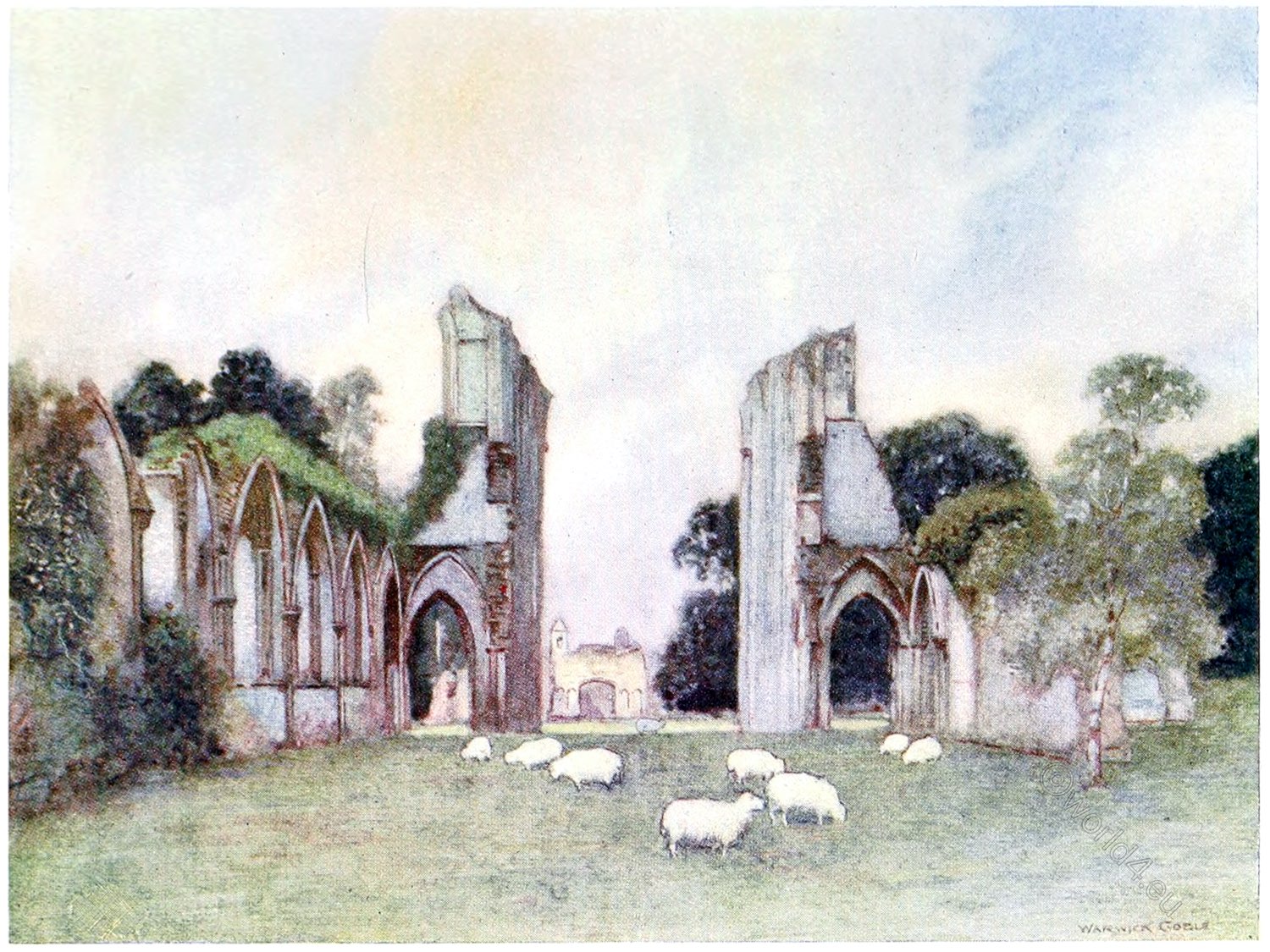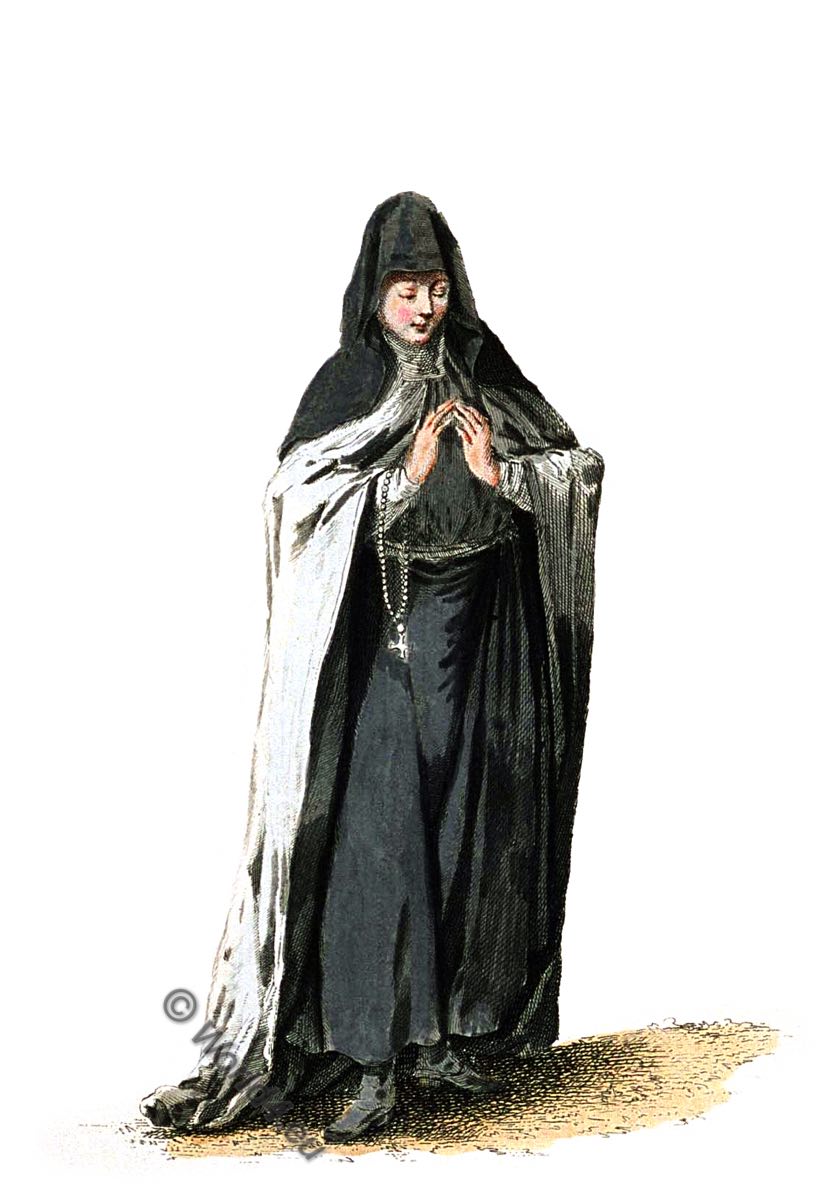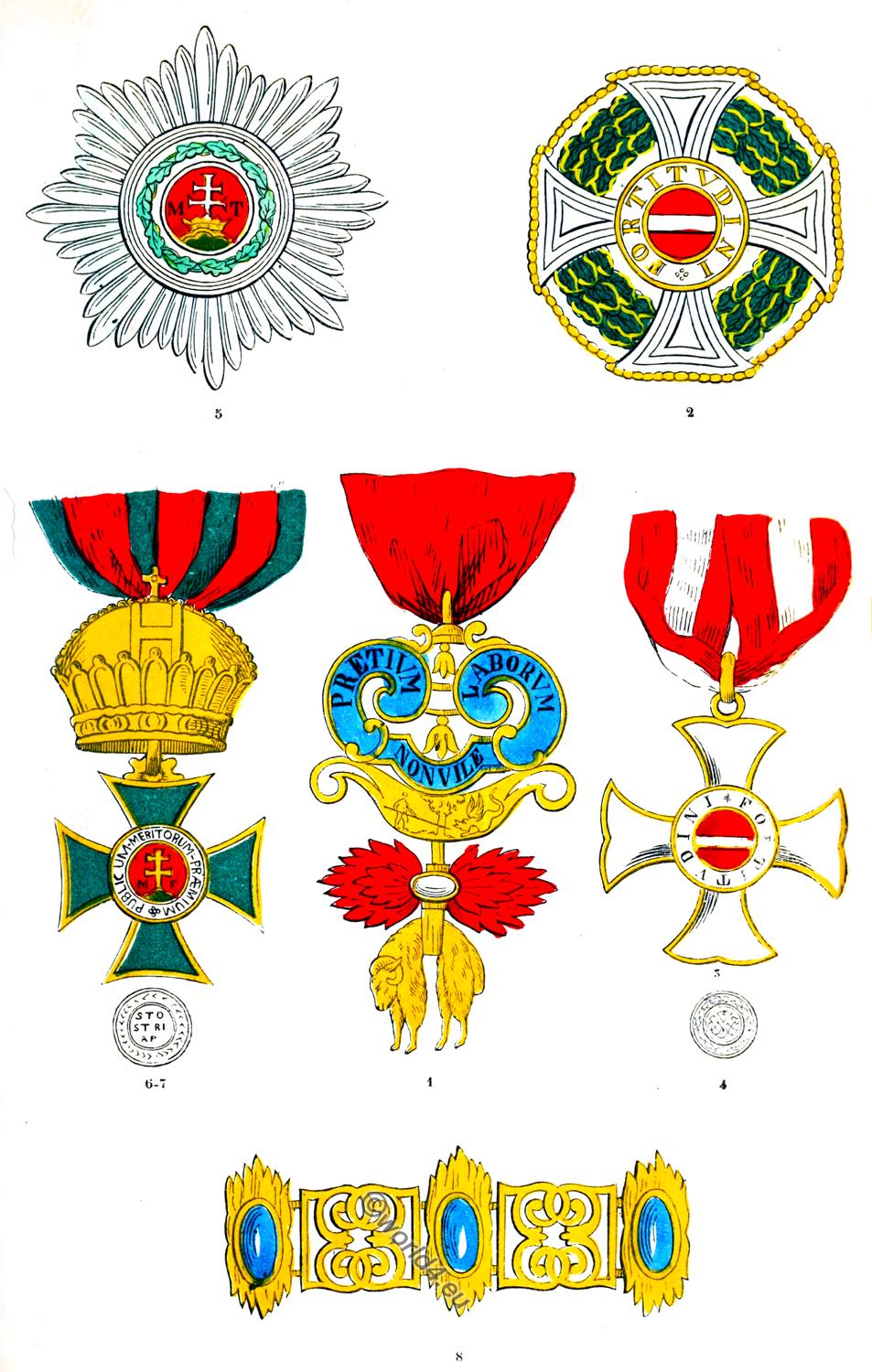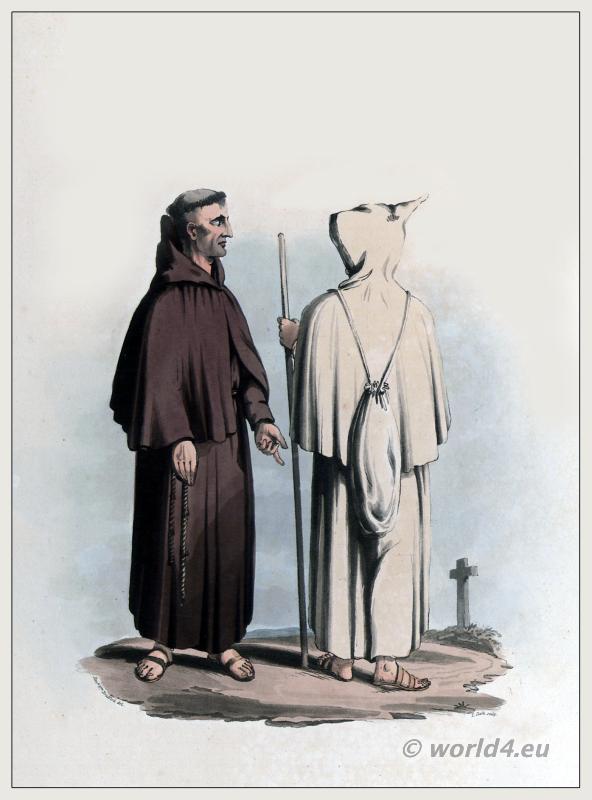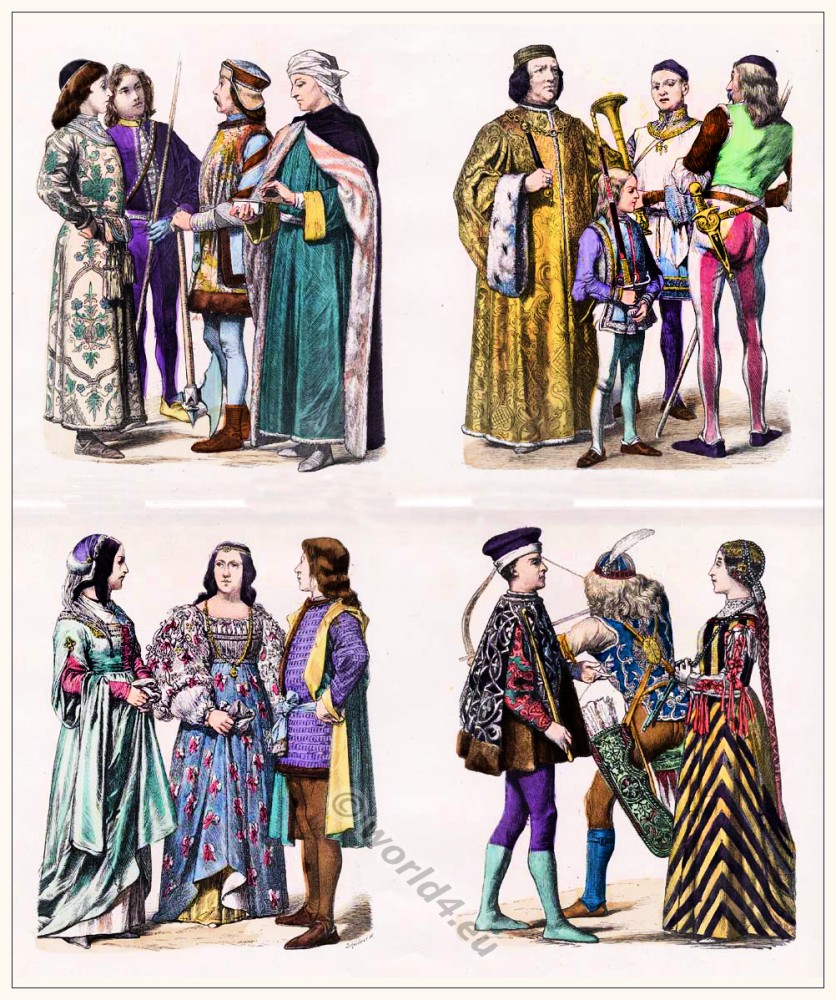The Abbey of Vallombrosa is located in the village of the same name in the municipality of Reggello, in the province of Florence in the Apennines and diocese of Fiesole, about 30 km south-east of Florence.
The Vallombrosans or Vallumbrosans (Latin Congregatio Vallis Umbrosae Ordinis Sancti Benedicti, order abbreviations: OSBVall and CVUOSB) are a branch order of the Benedictines in the Roman Catholic Church. They were founded in 1039 as a hermit community by Giovanni Gualberto OSB (985 or 995-1073, canonisation 1193). The female branch of the order was founded by St. Humilitas (1266 in Faenza; † 1310 in Florence).
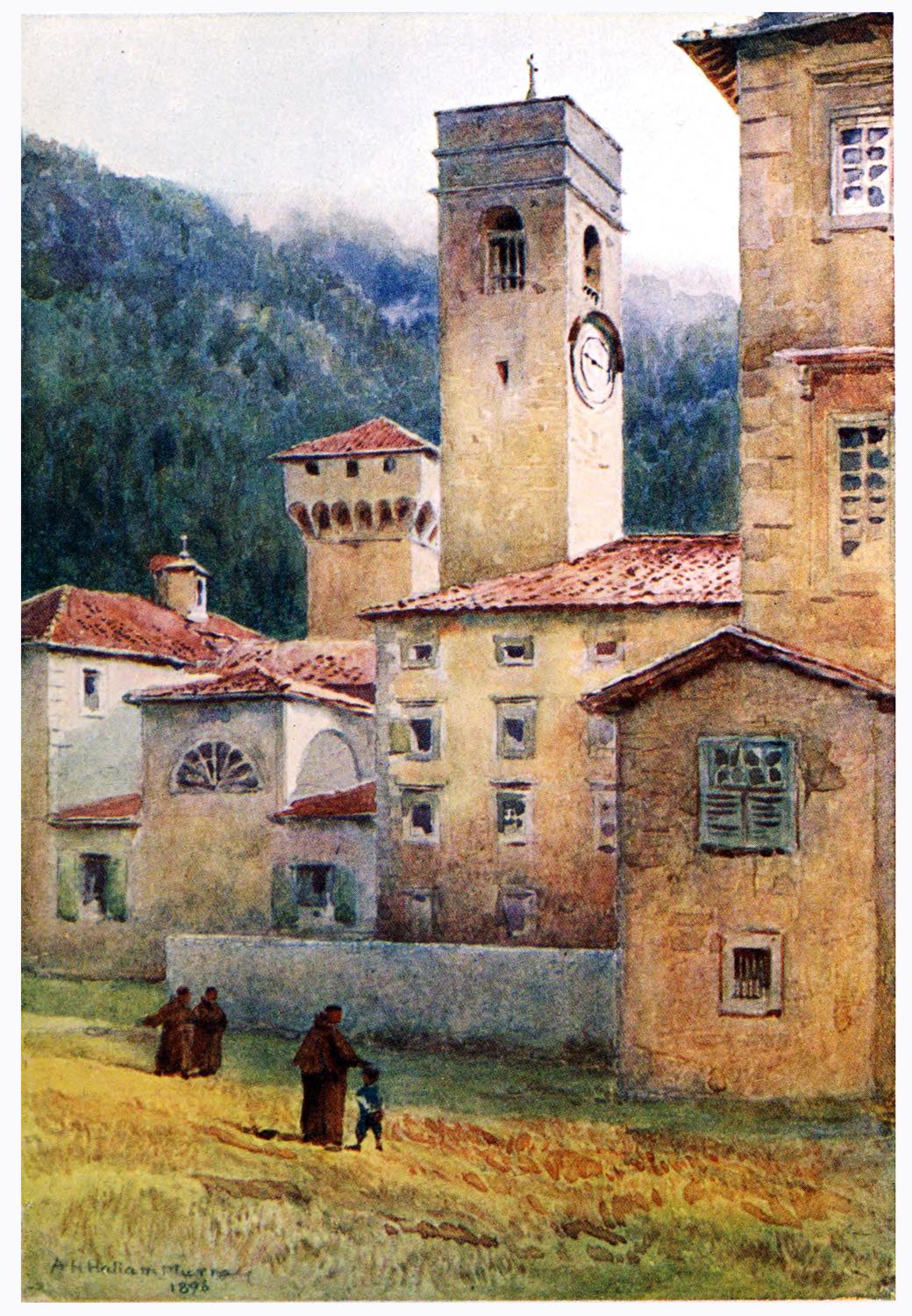
VALLOMBROSA, ABBEY.
by Alexander Henry Hallam Murray.
“SHOULD you be in Florence in the summer, visit Vallombrosa, one of the greatest natural curiosities in Tuscany, though Milton mentions only an ordinary circumstance, that of the fall of the leaves in autumn. You will be astonished the whole way at the boldness of the scenery: -and not least, at the mountain itself which looks proudly down on all that surrounds it.
San Giovanni Gualberto (985) founded the abbey in the midst of woods on the top of the Apennines, inhabited by wolves and bears; it has now become one of the pleasantest spots in Tuscany. A forest of chestnuts leads you to a forest of firs, and you at length arrive at the abbey, situated on a delightful lawn, enclosed in an amphitheatre of wood.” Beckford Utters.
CHAPTER XIII
VALLOMBROSA
Cosi fu norninato una badia
Ricca, e bella, ne men religiosa,
E cortese, a chiunque vi venia.
ARIOSTO.
ON the morning of March 26, 1003, it being Good Friday, a young knight, attended by a trusty squire, was riding towards Florence from the direction of Passignano. He was only eighteen years of age, high-spirited, we are told, and handsome, with a brilliant future before him, being at that time heir to his father Gualberto, of the noble house of Visdomini, Lord of Petroio in the Valdi-Pesa, and one of the leading nobles of Florence. The young knight has a particular look of earnestness and fierce resolve on his boyish face, though, for all that, he may still be struggling with his naturally noble feelings. For he has been brought up to love the Christian religion, and loves it, while now he has a most un-Christian, though very natural, piece of business on hand: he is in search once more, that he may kill him, of his archenemy, a relative of the house, the murderer of his only brother Ugo.
When he had passed by the Church of San Miniato, about half-way down between the church and the city, there, lo and behold! comes the enemy riding leisurely up the hill alone, unattended, unsuspecting, perhaps like a good Christian on his way to the Good Friday functions at the Abbey Church. Young Visdomini whipped out his sword, set spurs to his horse, and with a shout of triumph charged down the hill full tilt. But the enemy, seeing that he was a dead man, slipped from his horse, and kneeling on the ground, his arms crossed in saltire, was beseeching-not that his adversary would spare him, that was altogether too impossible to hope-but that the Lord Jesus, Who that day died for sinners, would have mercy upon his soul also, and spare him in the dread day of Judgment.
When this high-spirited lad saw in his enemy’s folded arms the sign of the Cross, when he heard the sound of the Holy Name, and recalled the solemn meaning of the Feast, a sudden revulsion of feeling came over him. He lifted up his abject enemy, embraced him tenderly, and in loving accents said to him: “Be thou to me in future a brother in place of my brother Ugo!” Then together they ascended the hill, entered the Church of San Miniato, where the Cluniac monks were celebrating the Mass of the Pre-sanctified, and there, as was the custom in those ages of faith, the young cavaliere confirmed in the presence of God that which he had promised in the sight of man. *
*Don F. Tarani, O.S.B. Della Vita di San Giovanni Gualberto. Udine, 1903, p. 12.
SAINT JOHN GUALBERT.
This noble, chivalrous, large-hearted youth was Giovanni de’ Visdomini, known to all the world now as Saint John Gualbert, first Abbot of Vallombrosa, and founder of the Vallombrosan Congregation of Benedictine monks; and if for centuries there has been a conspicuous home of sanctity at Vallombrosa, and if now it is one of the most delightful of summer resorts, it all had a beginning in the forgiveness of an enemy. It is no wonder that the Church, with a touch of that inspired genius which runs throughout the Liturgy, has allotted for the Feast of San Giovanni Gualberto a Gospel not to be found in the Common of a Confessor and Abbot, but the Gospel of the Friday after Ash-Wednesday: Diligite inimicos vestros, benefacite his qui oderunt vos, &c. (Matt.v. 43-48.)
Vallombrosa is now very easy of access: an hour about from Florence to Sant’ Ellero; about another hour in the Funicular from Sant’ Ellero to the Saltino station, and there we are, three thousand feet and more above the level of the Tuscan sea, gazing over all the beauties of the Val d’Arno Superiore, and only twenty minutes’ walk from the world-famed Abbey.
The Funicular railway was made in 1892 by the exertions of Count Joseph Telfener, since deceased. The system is cogwheel and infallible; no accident has ever occurred, for no accident could occur. We are pushed up the mountain side in open carriages, and freely enjoy a glorious view, passing first through vineyards and olive orchards, then constantly through mountain shrubberies and woods of juniper, arbutus, ilex, beech, and chestnut (how beneficently the air changes with the first appearance of the chestnut), until we land on a level with the pine-forests.
Outside the station is the Grand Hotel Saltino, finely placed to catch all the breezes from the four quarters of the globe; opposite is a Hotel “Milton,” as one might have expected after all those countless references to a certain quotation which nothing shall induce me to quote. Here, too, are the few shops and most of the villini and châlets.
On the road to the abbey we pass on the right the Grand Hotel Croce di Savoia on the left the noble Hotel Castello di Acquabella. I may call it noble (though they would fain have it “grand” also) for it is really a fine château in mediaeval
style, built for himself twenty-five years ago by Count Pio Resse, with no thought of the accommodation of pleasure-seekers. Soon we are in the first of the pine-forests with its “insuperable height of loftiest shade,” and the communal road takes on that billiard-table-like smoothness peculiar to roads that are sheltered by pines.
We pause for a moment to drink in the strong, exhilarating, aromatic odour of the forest, and my companion would fain have broken away for a sylvan ramble. But I am in haste to be at the abbey, and drag him reluctant a long with me. In a brief space the towers and campanile of that vast historic building come in sight, and in a few minutes more we have passed through the courtyard and found cool shelter in the dark Abbey Church.
The retrospective, the ruminative fit, as was natural in that place, came upon us, and our thoughts flew back centuries to another Abbey, the Cluniac Abbey of San Miniato above Florence, in whose church we left the young Cavalieri Giovanni de’ Visdomini perfecting the noblest act that one human being can do to another.
The ancient Crucifix of the church, now in Santa Trinita at Florence, graciously inclined to him in sign of approval of his heroic sacrifice, and Giovanni instantly became a changed man. He took refuge with the monks and begged to be made one of them. When Gualberto, the great and powerful Signore of Petroio, came to the Abbey in hot anger to take his son from the grasp, as he thought, of designing monks, Giovanni, standing before the altar, with his own hand cut off his thick long hair and clothed himself in a Cluniac cowl which he had borrowed.
This was an age when the virtues (like the vices) took giant shape, and the great heart of Gualberto was immediately subdued by his son’s heroism, while with a heroism almost as great, he reconciled himself to the loss of an heir, and saw his fief taken by another in the times to come. Giovanni, perhaps in admiration of this magnanimous father, added the name of Gualberto to his own, and the two names have remained inseparable eversince. I never see him in art, or in his churches, without thinking of the father’s sacrifice as well as of the son’s, and I trust that the shadowy tradition may be true which makes Gualberto die at Vallombrosa, a holy monk.
Giovanni Gualberto remained four years in the Cluniac Abbey of San Miniato, and so greatly had he edified all by his wisdom, fervour, and sanctity, that the monks at the end of that period elected him their Abbot. This dignity he declined, and to make a long story short, departed from San Miniato, by leave of his superiors, with one companion, in search of a hermit life on the Apennines. In his wanderings he came to Camaldoli, and stayed awhile in the new flourishing hermitage there, taking counsel about his state with that wonderful man of God, Romuald.*
It might have been thought that here, in this holy camp with so holy a leader, Giovanni Gualberto would have realized his ideal; but he felt himself called, though as yet he saw not the way, to a life in some respects different, and again he set forth on his wanderings. Saint Romuald parted from him with tears,gave him his blessing, and taking him aside uttered a prophecy of the future greatness of his institute, which is famous in the Vallombrosan Order.
These two great Saints at parting vowed a perpetual fraternity between their two institutes, and for a long time if, say, a Camaldolese was visiting Vallombrosa, he would take off his own and put on a Vallombrosan habit as a symbol that the monks of the two orders were brothers. The same custom prevailed, of course, if a Vallombrosan visited Camaldoli. Don Diego de’ Franchi records having witnessed it in 1609.**
*Saint Romuald was some thirty years older than Saint John Gualbert. He was born about 956, and died in 1027.
** In his “‘ Historia del Patriarcha S. Giovangualberto.” Florence, 1640, p. 77.
BLOSSOMING OF THE DESERT.
Saint John Gualbert went down the mountain side, and setting his face towards Florence, crossed the smiling Casentino, and climbing, very likely, the Consuma Pass, came to a place on the Secchieta called Acquabuona, or Acquabella (hence the name of the modern hotel), from the excellence and abundance of its water. This place is now more fitly called Vallombrosa, the shady valley, from its pines. But when Giovanni Gualberto came here all was bare rock. It is true that pines will make their own soil, but they need at least some soil as a beginning.
That beginning was placed there by the fostering hand of the monks, and so it may be said, in a sense, that they not only planted the forests, but made the very soil of this enchanting spot. Dig but vigorously enough, and you will soon come upon the bedrock in the forests. Our holy wanderer found that Acquabella was too near the road for his pious purpose, and penetrated further into the forest. There, to his astonishment, he found a little hermitage newly-made of the branches of trees, inhabited, to his still greater wonder, by two monks of the Abbey of Settimo, living thus by leave of their Abbot. He, with his companion, joined himself to them, and in these four Religious we have the first beginning of the Vallombrosan Institute.
This was in the year 1008, * but according to tradition, Giovanni Gualberto lived as an almost complete solitary under the shelter of a beech tree for another seven years
Contento nei pensier’ contemplativi.
Par. xxi. 117.
* The dates I give here are the traditional ones, and are open to some objections. Needless to say, this rapid little sketch makes no pretensions to critical accuracy.
We shall see a third descendant of this beech, sprung from the original root, on our way up from the Abbey to the Paradisino. By 1015 the hermits had grown in number, and drew closer together in cells surrounded by an inclosure; the eremitical idea was on the wane, the coenobitic about to spring into vigorous life. It is wonderful to read of the great freedom of the spiritual life among these first athletes of the Vallombrosan Order, a freedom possible only in the days when there were giants moving on the interior way.
These early hermits had not even a Superior; each hermit consulted with that hermit whom he thought likeliest to draw him nearest to God, and though they professed the rule of Saint Bennet, yet the width and elasticity of that great spiritual charter left them room for the greatest diversity of life. But such periods in the religious state are rare after the first great centuries of the Christian Commonwealth. The great work of Saint Romuald was to discipline the hermit life of his day, and redeem it from the fantastic exaggerations which are the danger of the solitary not living under regular obedience. Saint John Gualbert, by his great sanctity, his expert direction in the interior life, his commanding gifts and qualities, unconsciously developed into the leader of these recluses.
A TWO-HEADED DRAGON.
Itta, of the noble house of the Counts Guidi, abbess of the nunnery of Sant’ Ellero at the foot of the mountain, was the ground landlady of these forests, and proud to have such holy men on her abbatial possessions, she presented them with a large tract of land. Giovanni Gualberto here built a modest monastery. He had a work to do, and needed monks whom he could send out into the world, and not hermits who would be bound to perpetual seclusion. Vallombrosa was then, and still is, in the diocese of Fiesole, and chroniclers assign the year 1018 as the date when the Institute was canonically erected by episcopal sanction.
Not without a purpose did the saint now find himself living within sight and reach of Florence. Simony was rife in that diocese; Nicolaitanism flourished and grew apace: Saint John Gualbert was to become the terror of the Simoniacs, the hammer of the Nicolaitans: the two-headed beast that you will sometimes see in art under his feet symbolizes the twin monster that was ravaging Tuscany at the time. By the end of his long life he and his monks had scotched, if not killed, the devastating dragon. They suffered persecution, spoliation, martyrdom even, at the hands of the avaricious and licentious, and cheerfully sacrificed themselves at all times for the welfare of the poor and ill-used. But into their long and gallant struggle for religious and moral reform it is impossible to enter here. I will briefly narrate but one incident typical of the times, because it is great in Vallombrosan annals, and has often been represented in art.
Pietro Mezzabarba had been simoniacally intruded into the see of Florence through Imperial influence. The fact was denied by the Bishop and his partisans; Saint John Gualbert knew the truth well enough, and openly denounced the Bishop. Recourse was had to Rome without success, for want of clear evidence perhaps, or owing to the skilfully used influence of Bishop Pietro.
One night in 1062 the abbey of San Salvi, outside the old Porta alla Croce, which had come into Vallombrosan hands, was stormed by a band of desperadoes, emissaries of the infamous Bishop. The monks were in choir at the time: some were killed: all wounded and ill-treated: the abbey was sacked and finally set on fire. But the attack failed of its only object: the murder of the aged saint whose expected arrival there had been delayed by a day. This piece of villainy roused the people of Florence to the full.
The agitation for the deprivation of the Bishop increased. But six years passed without any remedy. Then the people appealed to Saint John Gualbert to permit a judgment of God by fire, so that Rome, Florence, and all the world might be convinced that their Bishop was a simoniacal intruder. The saint consented. It was a thoroughly popular movement, organized, pushed on, and carried out by the people themselves. The place selected was the piazza in front of the Abbey of Settimo, by that time also a Vallombrosan house. Settimo is situated on the left bank of the Arno, between Signa and Florence, about six miles from that city.
JUDGMENT BY FIRE.
It was February 13, 1068; men and women, clergy and laity, to the number of five thousand, streamed out of Florence at an early hour of that chill February morning. Saint John had chosen one of the lights of his Order, Don Pietro Aldobrandini, to undergo the terrible ordeal. The people piled up two great bonfires on the piazza in front of the Abbey Church, leaving a narrow passage between the two. Don Pietro said his Mass devoutly within, and having reached to the Agnus Dei, four monks came forth-one with a crucifix, another with holy water and an aspergillum, the third with a censer, the fourth with lighted candles. The stacks of wood were solemnly blessed and set alight from the blessed candles.
When Mass was over, Don Pietro appeared, a serene imperturbable figure, having divested himself of his chasuble, but still wearing his alb, stole, and maniple, and bearing a cross between his hands. After praying aloud that God would show forth the justice of his judgments, he gave all his brethren the kiss of peace, and having signed himself with the cross he bore, he tranquilly entered the flames. Arrived at the end of the fiery alley, he found that he had dropped his maniple, and turning back to fetch it, again emerged scatheless from the fire. Then came his real danger: suffocation from the devotion of the people who crowded round him to kiss his hands and feet and sacred vestments.
This, according to tradition, is the incident which gave the death blow to simony in Florence. The circumstances are related in an extraordinarily vivid and circumstantial letter of the clergy and people of Florence to Pope Alexander II., praying him, after this evident manifestation of the finger of God, to remove their simoniacal Bishop.* Don Pietro was canonized, and is known as San Pietro Igneo from having passed unscathed through the fire. There is a picture of him in the sacristy of Santa Trinita at Florence, and a relief on one of the panels of its doors.
Saint John Gualbert died in 1073 aged eightyeight, in the Abbey of Passignano, Val-di-Pesa, not far from the Castle of Petroio, the investiture of which he might at that moment have been enjoying, had he not chosen the better part. His feast is celebrated on July 12, now attended at Vallombrosa by many unlooked-for holiday-makers; his Order was solemnly confirmed in 1055; he was canonized by the voice of the people during his lifetime, and, after death, by Pope Celestin III. in 1193. The colour of the habit was at first grey; ** – afterwards changed to brown; and finally, in the sixteenth century, to black, as we now see it.
* This letter may be read in the original Latin and in an Italian translation in Don Diego de’ Franchi’s Life of the Saint, p. 453. Also in Latin in the Acta Sanctorum. Tom. iii. Julii, p. 376.
** It is said that Saint Francis, coming to Vallombrosa in 1224, on his way to La Verna, being wet through, the Abbot made him put on his grey cowl, in which the Saint finally departed: hence the grey of the early Franciscan habit.
THE FIRST LAY-BROTHERS.
As in the Camaldolese Order, so in the Vallombrosan, the eremitical life existed, but with a difference: Saint John Gualbert’s sons were all professed as monks, some of whom volunteered as hermits; Saint Romuald’s sons were all professed as hermits, a number of whom lived as monks by reason of the demands upon their hospitality.
But the hermits of Vallombros a were never numerous, and the eremitical life had practically died out at the beginning of the eighteenth century. Note that Saint John Gualbert, though an abbot, was not a priest, was not even in minor orders, and so great was his humility and his veneration for the clerical state that he would not himself open a church door, but required that office to be done for him by one who was at least in Ostiarius’ orders. He was the first founder to introduce the system of laybrothers, now followed by all Orders.
Of course there were plenty of monks in monasteries not in orders and in that sense laymen, but they were choir brothers and lived the regular community life. On account of the extensive manual labour at Vallombrosa, Saint John instituted lay-brothers, dispensed from office and attendance in choir, except at midnight. He introduced another great change into the religious life which has also been very generally followed. There was no Order in his day with one single chief. Each monastery was separate in itself, governed by its abbot, and no interchange of monks between one house and another was possible, because each monk had taken his vows for a particular house. Saint John Gualbert obtained that all the Vallombrosan monasteries should be subject to him as Abbot-General. (And since I am here speaking of the first Order that ever had a head, a mild protest against the wrong use of the word “General” in such a connection may not be out of place.
There is no such thing as the “General” of an Order; “general” is but an adjective determining the extension or quality of the real title: thus the head of the Friars Minor is a Minister-General, of the Dominicans a Master-General, of the Austin Friars a Prior-General, of the Minims a Corrector-General, of the Salesians a Rector-General; nay, there is not even such a person as a “General of the Jesuits”- their chief is a Provost-General: the only religious body that may lay claim to a “General” pure and simple is the Salvation Army.)
The Vallombrosan Order is an essentially Tuscan institute. It spread certainly to Umbria, Lombardy, the Republic of Genoa, Rome, and there were once two houses in France. But it never really flourished outside Tuscany, and I believe the only non-Tuscan house now in existence is Santa Prassede in Rome. The Abbot-General was accorded many privileges by the Grand Dukes,and often held high office at Court: for this reason he was practically obliged to live at Santa Trinita in Florence, and was, I believe, the only head of an Order who did not reside in Rome. Even in quite recent times he was still in Tuscany-at Pescia and only transferred his residence to Rome about three years ago.
.
It were impossible now to dwell upon the history of Vallombrosa, to write of the holy and great men it has produced, of the art treasures that once were here, of all that this home of learning and sanctity has done for literature, science, art, education, and the general well-being of mankind.
AN ABBEY AND A COLLEGE
I suppose that next to Montecassino (also Monte Cassino) it is the most important Abbey in Italian history. It seems to have attracted all the world. No grand tour was complete without a visit to Vallombrosa. Beckford was here in 1780, and behaved rudely by his own showing.* He writes charmingly of the natural scenery, but is in a constant state of open, petty irritation with his kindly hosts. To him monks do not walk, they “waddle”; to him instead of pictures of health, owing to a simple life in a life-giving forest, they are “overgrown” “sleek” “rosy” “round” all except one who, for stage purposes, becomes a “tall spectre of a priest,” driving the “pale and wan” Academy of Noble Florentine Youth before him “like a herd” to “their dark inclosure,” and, he adds tragically, “presently the gates opening I saw them no more.”
How droll this note of tragedy sounds to the present generation; how could he expect to see them “more” if it were bedtime and there was a door between him and them? Mr. Eustace, of “Classical Tour” fame, was here in 1802, and for once writes sympathetically of a religious house. “The reader will learn with pleasure,” he says, “that the monks of Vallombrosa are not idle solitaries; but that they unite like most of the ancient and many of the modern Benedictine establishments, the labour of public instruction with monastic discipline.
* “Italy.” Letter No. xvii.
Thus Vallombrosa is both an abbey and a college, and in its latter capacity furnishes an excellent seminary for the education of the Florentine youth of rank, many of whom were there at the time of our visit. Their dress is a black gown, with a black collar lined and edged with white; we were present at one of their amusements, which was the Calcio, or balloon, a game in great repute both in Italy and France. Their looks and manners seemed to display the advantages both physical and moral of the situation.” (Vol. iii. p. 383.)
The pallor and wanness of the Florentine youth of rank have disappeared since Beckford’s visit twenty-two years before, and from a cowering driven herd, dominated by the spectre of a priest, they have developed into noisy, romping schoolboys, the picture of health and happiness. Rest assured that Beckford’s waddling monks had no more real existence than his pale, wan, driven schoolboys. Prejudice (and the” superior person” in him) had completely sealed up his eyes in such matters, and make him, man of talent though he was, a very bad judge of men and things in Italy.
ISTITUTO FORESTALE
The records of famous visitors to this historic place are full of interest, but it is time that we took a glance at modern Vallombrosa. Opposite the entrance to the abbey is the Grande Albergo della Foresta (more grandeur), delightfully situated as its name implies in the midst of the forest. This was once the Foresteria, or guest-house of the abbey, now considerably added to, and here, according to monastic ideas of hospitality, all the world, rich or poor, might have three days’ entertainment free of cost. The abbey itself, the church, shrines, chapels, observatory, hospice, Paradisino, farmhouses, lands, and forests, were taken possession of by the Government in 1866. *
* In 1869, a national forestry academy (Regio Istituto Forestale di Vallombrosa) was founded in the abbey of the Vallombrosans near Reggello in Tuscany, which had been abolished at the time, and which later became the agricultural faculty of the University of Florence.
The abbey buildings are occupied by the “Istituto Forestale,” the only Italian Government school of forestry. Students are admitted at seventeen years of age, and go through a four years’ training, when, after passing examinations, they enter the Government forestry service. They are in residence from March to November only, so that in the heart of winter Vallombrosa takes on something of its old aspect of solemn peace.
The school of forestry is a very well managed institution, and has given excellent results. At present there are only thirty students there, but in past years I remember as many as seventy. The students themselves occupy the airiest corridor in all the abbey, precisely that “dark inclosure” once inhabited by the Florentine youth of rank. Permission to visit the Istiuto is very readily granted, and it is a somewhat odd mental process to inspect an up-to-date institution housed in an ancient abbey.
There is the refectory tel quel, pictures, tables, seats, pulpit, just as it was in the days of the monks, while opposite, the refettorino, or refectory of the lay-brothers, with its inscription over the entrance still standing, Regnum Dei non est cibus nec potus, has been turned into a gymnasium, while a picture of the genealogical tree of the Vallombrosan family confronts the students in their fencing exercises. The fine machicolated tower that you see in the sketch (dating from the 13th century) was used as a prison for the transgressors against the monastic rule, and in the first days of the Istituto as a disciplinary prison for the forestry students. It is now entirely disused.
In a small corner of the abbey building dwell three monks. They are placed there by the Government as custodians of the church. One of them, too,* is in charge of the Observatory, whence reports are made every ten days to Rome, and monthly to Florence. Once upon a time the monks were so numerous that the choir would not hold them, and they had to divide into three choirs. The office was thus repeated thrice during the day; so that there was scarcely an hour in which the Divine Praises were not ascending from the Abbey Church. Even at the time of the Napoleonic suppression in 1808, there were some eighty religious. And now but three survive to represent the majesty of that triple choir and the noble traditions of the second greatest abbey of Italy.
Vallombrosa, mother house of the Order, is actually without a Novitiate, and no longer has a bed to offer to the once eagerly welcomed traveller! To me it is pathetic-as it certainly is heroic-that these three monks still struggle to keep up office in choir. Beckford, in the phraseology of his day, would call it a “droning” or a “mumbling”: we of a more generous age can catch in it the notes of a spirit chant, faint no doubt, a swan-song perhaps, but while it lasts Vallombrosa is still an abbey.
* Don Basilio Domenichetti. I desire to call particular attention to his “Guida Storica di Vallombrosa,” published in 1903. It is an excellent guide, accurate historically, and up-to-date practically, and moreover has the advantage of being writ in very choice Italian.
A DESOLATE SANCTUARY
There is not much now to attract us in either church or abbey. The vandals have been busy here; almost all that ennobled church and abbey has disappeared. It is by no means all the doing of modern hands. Certain Imperial vandals began the work of spoliation and destruction in the sixteenth century, and another species of Imperialist continued it in the early nineteenth. There is still one treasure: the superb reliquary containing the right arm of San Giovanni Gualberto. It bears date the last year of a fin de siècle that is very glorious in Italian art, 1500, and Paulus Solianus aurifex me fecit. The lover of art should not miss seeing it, and, if that is anything to him, he may here see it in its right place and put to its right uses.
There is a certain feeling of desolation about Vallombrosa. When I first came here the numerous shrines dotted about the forests were all desolate. They are many and full of memories: there is the Chapel of Saint Jerome; the Chapel of the Faggio Santo, or Holy Beech, under which Saint John Gualbert lived in solitude seven years; the Chapel of San Torello, a famous Vallombrosan lay-brother, which served as Oratory for women in the days when they were not allowed en trance to the church; the Chapel of the Blessed Migliore, another laybrother, situated below the rock of the Paradisino (beside it is the cave in which the famous hermit died in 1138); the Chapel of the Fountain of Saint John Gualbert; the little chapel built on the Devil’s Rock, or Massa del Diavolo, from which a recreant to the religious life threw himself.
By the energy of those in charge of the Istituto Forestale the mere shells of these shrines and chapels have been restored to seemliness and add to the picturesqueness of the woods: that is but one half of the unity: the images which have disappeared, the rude frescoes which have been defaced, still need to be made good by some generous hand. But we are grateful for the half-loaf that is better than no bread. Owing to the easy access from Florence, the becero can come here for a Sunday outing, and like the becero of all the world, though he come from the best-mannered city in all the world, he is not above scribbling his unknown name-would that it were writ in water-on the walls of the shrines, and at times even of indicting the vapourings of a fatuous and misguided mind. A sentinel with a blunderbuss alone, I suppose, could prevent desecrations which are the grief of the judicious and the torment of the ecclesiologist.
The Paradisino
From the abbey a beautiful walk through the pines leads us up to the Paradisino, 3400 feet above the sea. In this magnificent position was once situated the hermitage of the Order: a number of little cells dotted about at irregular distances and enclosed by a wall. Its old name was Le Celle. Hence the Blessed Giovanni delle Celle, a fourteenth-century glory of the Order, who, having so far transgressed the rule as to merit eleven months imprisonment in the tower, atoned for his fault by years of penance in the hermitage.
To the Ven. Peter Migliorotti of Poppi (ob. 1679) the place seemed so like a foretaste of paradise that he called it the Paradisino, and so it has been called ever since. The cells were pulled down as the eremitical life declined in the Order, and a small monastery, or to use the technical term, which here would have been confusing without explanation, a cell, was built in their place. This has now been destroyed and a very charming hotel built on the spot-the Hotel Paradisino- which retains so much of the old character of the place that it chiefly attracts people who like a quiet life.
There is nothing “grand” about it except its position. The air here is particularly invigorating; the view magnificent; I can look away over to Incontro, the dour Retreat of Saint Leonard of Port Maurice, and Monte Senario, so closely associated with Servite history; I can see all the domes and towers and spires of Florence, and on some days even the shimmer of the Tyrrhenian Sea. I grieve to say that the old chapel – sole remnant of the monastic institute up here – has been turned into the modern dining-room, so that the place where the elect spirits of the Order were often visited by raptures in saying Mass, now echoes to the clatter of busy knives and forks, and the bright talk and laughter of people who have had a happy morning on the mountain side. It is a pity, since the little monastery had to go, that the chapel did not go along with it. The present circumstances are enough to deprive both the hardy mountaineer and the dry-as-dust archeologist of hunger and thirst.
I have spoken of the desolation of Vallombrosa, but would not be misunderstood. It is the brightest place imaginable. From having been for centuries a place of the other world, it has now as emphatically become a place of this world, and a very pleasant place, too. Only those plagued with the historic mind could have any qualms on a visit here. In England our abbeys and abbey churches are in ruins: we can sentimentalize about them: our poets have told us how to see them right; and they make such admirable places of picnic. It is difficult to sentimentalize properly about an abbey building still entire and put to upto-date uses, just as it impossible not to bemoan the absence of those treasures which once ennobled it.
And that leads me to say how odd is the goodnatured modern readiness to admire things uprooted from the places which gave them half their beauty and all their significance. The modern will go into a museum, and rejoice that by one visit here he may see in cold meaningless isolation priceless objects for the sight of which, in days gone by, he would have had to make a score of adventurous excursions into the by-ways of Tuscany.
Here in a museum he can see bells on pedestals which should be ringing out from church spires or palace towers; statues taken from over the town gates of the chief seat of some noble captainry: coats of arms torn from the façade of a Palazzo Pretorio; pictures, painted to glorify a church, and shine in a particular light first lovingly studied by some master mind; frescoes, chipped bodily out of the solid walls they were meant to adorn; vestments under glass cases that should be folded in sacristy presses; missals and choir books open at one illuminated page, which should have been turned over and over again during the ecclesiastical year; images of madonnas and saints, symbols to the people of living devotions; sanctuary lamps that proclaimed the Light of the World, and crucifixes meant to proclaim the Redemption of mankind; monstrances for the blessing of the people, and pyxes for the safe carriage of the Holy Viaticum; nay, he may even gaze upon pulpits from which no message of comfort will ever again be delivered to the world, and whole sets of inlaid choir stalls from which the Divine praises will never again ascend to heaven.
Siste viator: pause and reflect a moment. Is this altogether an un- mixed blessing?
If all these things have ceased to have meaning, is that any reason why they should be wrested from the places where they once had meaning, where alone the student of the past who, rest assured, will continue to plague us unto the end of time can rightly study and understand them?
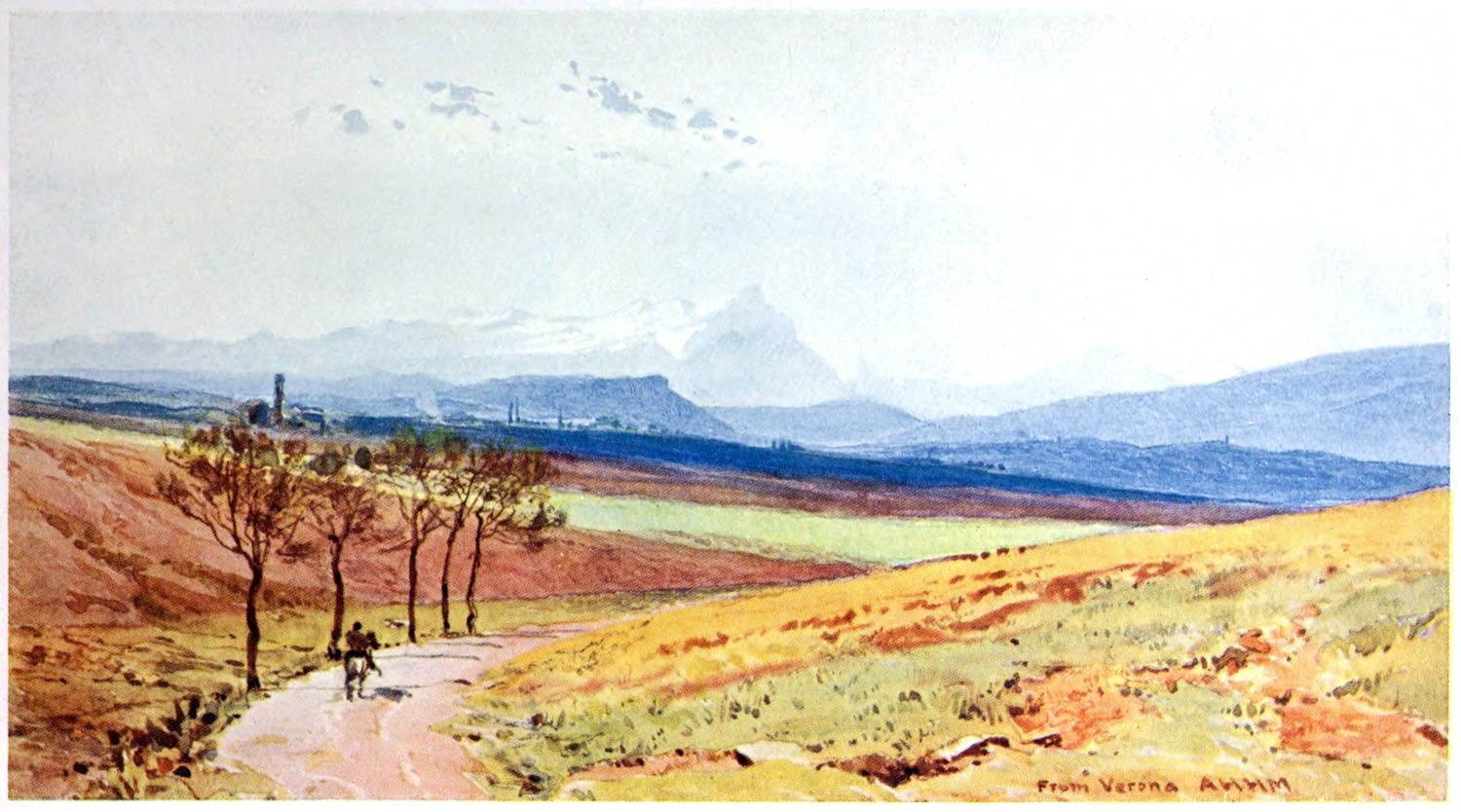
THE ALPS FROM VERONA.
“THE strange sweeping loop formed by the junction of the Alps and Apennines [encloses] . . . the great basin of Lombardy. . . . All the torrents which descend from the southern slope of the High Alps and from the northern slope of the Apennines meet concentrically in the recess or mountain bay which the two ridges enclose; every fragment which thunder breaks out of their battlements, and every grain of dust which the summer rain washes from their pastures, is at last laid at rest in the blue sweep of the Lombardic plain.” Ruskin.
To see the former treasures of Vallombrosa I must pay francs to get into museums, or secure letters of introduction to private houses; I might even have to make journeys through the length and breadth of Europe, or cross the Atlantic for a time of travel in the United States. And what availeth it me if I see a Delia Robbia once in Vallombrosa, and have not first seen Vallombrosa itself? The modern mode of seeing sights is no real education, because it has no regard to the unities that slowly grew under great creating hands in a mighty past. These unities are dead, or dismembered, according to the point of view. What then ? The past will remain for ever dead to us unless we at least gather together those unities ontologically, and give them a real existence in the inner sanctuary of the mind. It is precisely the greed of the private collector, and the overweening ambition of national museums, that add to the difficulty of our studies by dismembering that which should have been left whole, and sequestering from active life that which was made for a living use.
But whither am I traveling with these unwonted reflections? Full tilt at a company of well-armed critics, point blank against the dearest of national prejudices. I’ll stop and go no further. These reflections were drawn from me by the desolation of Vallombrosa: I hasten to repeat that it is one of the brightest, blithest places in all the length and breadth of radiant Tuscany.
Source: Sketches on the old road through France to Florence by Alexander Henry Hallam Murray. Publisher London: J. Murray, 1905.
Related
Discover more from World4 Costume Culture History
Subscribe to get the latest posts sent to your email.

